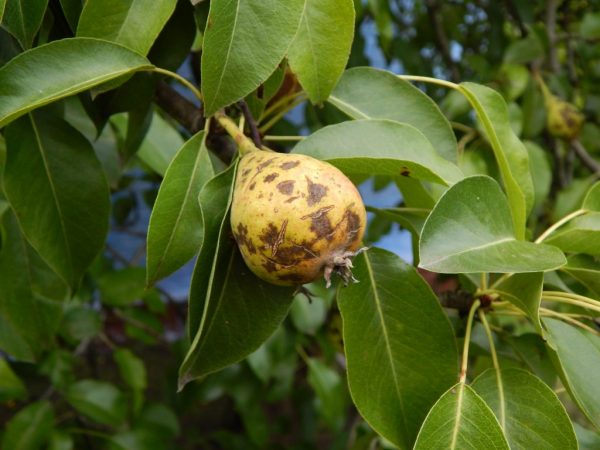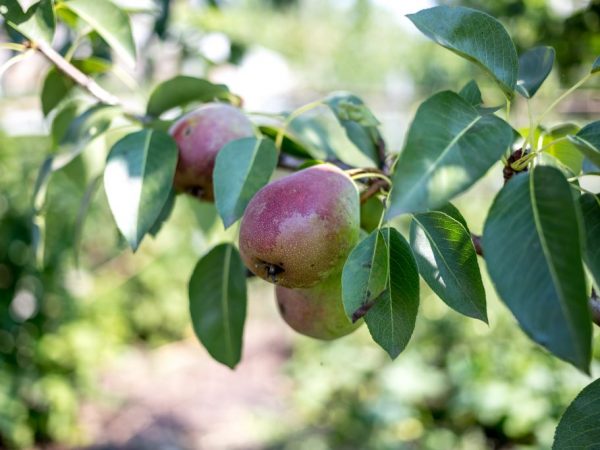Causes of pear blackening and treatment methods
The pear is quite unpretentious to care for, its fruits delight with their taste and aroma. But sometimes changes begin to occur in the appearance of the crown, branches and fruits. The shoots change their color and the leaves turn black on the pear. Why do they turn black? There may be several reasons for this.

Causes of pear blackening and treatment methods
Causes of blackening
Before starting treatment, it is necessary to study the reasons why the leaves of the pear turn black. It is the process of color change that helps to determine the factors that influenced this:
- lack of trace elements;
- dry air;
- bacterial disease;
- fungal disease;
- honeydew;
- aphid.
Each of the reasons has its own characteristics and features of development. Having studied them, you can easily establish why the leaves of pears turn black.
Lack of micronutrients
In order for the pear to grow well and bear fruit, it is necessary to regularly feed with nutrients.
Signs of insufficient intake of certain micronutrients:
- with a lack of potassium, the tips and edges of the leaves turn black;
- the rosette has darkened, the top of the young branch gradually dries up, and the leaves have also turned black - all these are signs of a lack of boron;
- iron deficiency is manifested by a sharp lightening of individual leaves, they become light yellow in color.
Dry air
A large percentage of dust in the air has a negative effect on foliage. With prolonged drought, the leaves of pears turn black even under conditions of regular watering.
Bacterial disease
The first signs of bacterial disease begin to appear in early summer. Initially, the leaves turn brown and over time, the leaves of pears turn black, acquiring a burnt appearance. The disease affects not only the leaves, but also the branches, roots and trunk. The infection enters the plant through cracks, slices, and an uncontaminated instrument.
Fungal disease
Fungal diseases of pear include scab. Fungal spores infect the entire plant with great speed. The scab quickly spreads between plants and if left untreated, the pear can die. Black dots appear on the surface of the leaf, trunk and fruits. Gradually, the dots merge and form large spots. The leaves fall off, a black bloom forms on the fruit, the fruit stops developing and cracks.
Pests
Medianitsa
Copperhead is an insect, small in size, dark brown in color. Thanks to small wings, it moves freely throughout the tree and the site. The insect itself and its larvae feed on the sap of the plant, leading to the depletion of the tree, a decrease in the size of the leaf, and the death of flowers and ovaries. The larvae secrete a sticky liquid that sticks together the buds and peduncles. On a sticky liquid, black fungi develop very quickly.
Aphid
The foliage has turned black and wrinkled. Small insects are visible inside the leaf. All these factors indicate that aphids have appeared on the site.Aphids do great harm. It sucks out most of the juice, and with it the nutrients. Aphids are especially terrible if they have settled on a young pear. Due to the loss of nutrients, immunity weakens, and green leaves can become infected with bacteria and fungi.
Methods to eliminate the causes of blackening
Lack of micronutrients

Top dressing will help to cope with the problem
To replenish the deficiency of micronutrients, feed:
- if there is a lack of potassium, add potassium chloride to the soil at the rate of 10 g. per 1 m 2 or wood ash, spray the pear with a solution of 50 gr. potassium salt and 10 liters of water;
- to eliminate boron deficiency, treat, at the beginning of summer, the tree with a 5% solution of boric acid, once every three years add boric fertilizers to the soil in an amount of 5 grams. for 1 m2;
- for the treatment of iron starvation in the fall, it is necessary to fertilize the soil, add 1 kg of ferrous sulfate under each sprout, every spring spray the crown and branches 2-3 times with a solution of 50 grams. ferrous sulfate and 10 liters of water.
Dry air
Most often, southern pear varieties suffer from dry air and a large amount of dust. To cope with the dry air factor, irrigation through sprayers will help.
Bacterial disease
With a bacterial disease, there are several ways that a plant can be saved:
- Spray the plant with antibiotics diluted in water, you can make a solution from penicillin, thiomycin, agrimycin. Spray for the first time during flowering and continue every 5 days.
- If the disease is at an early stage, spraying the entire area with a solution of copper sulfate helps.
- In severe stages of the disease, you need to use strips of cloth soaked in a solution of 1 tablespoon of copper sulfate and 10 liters of water. Dampen a cloth and wrap the entire barrel with it. To prevent the stripes from drying out, secure the perforated bottles of solution at the highest point of the fabric. Lower the ends of the fabric into a container located in the hole near the trunk. Continue this treatment for 14 days. Spray all branches with this solution every two days.
- If the seedling cannot be cured, it must be removed from the site and burned.
Fungal disease
To prevent scab, spray the fallen leaves and the periosteal circle with a 7% urea solution. If it was not possible to prevent the disease, it is very important to start treatment at the first signs of damage to the plant by the fungus.
Scab treatment consists in spraying the crown with various solutions:
- One of the most effective drugs is Bordeaux liquid. Spray every two weeks throughout the season.
- Before budding, treat the plants with a solution of 300 g of copper sulfate, 350 g. lime and 10 liters of water. After that, treat every two weeks with a solution of 100 grams. copper sulfate, 100 gr. lime and 10 liters of water.
- Treat with mineral fertilizers. At the same time as the treatment, make a foliar dressing. For spraying, prepare a 7% fertilizer solution. For this, ammonium or potassium nitrate, potassium salt, potassium sulfate and potassium chloride are suitable.
- spray the green mass with special preparations purchased in the store. Use them strictly according to the instructions.
Remove fallen fruits and leaves from the area regularly, as they are sources of infection.
Pests
Medianitsa
Having found a sucker on a pear, the black leaf is covered with holes - start immediately to fight the pest.
- If the insect is found before bud break, treat the trunk and branches with hot water, the water temperature should be about 60˚C.
- Spray the crown of the plant with 0.2% karbofos solution. Carry out the procedure until flowering.
- Spray the branches with the preparation No. 30 until the leaves appear. In the absence of the preparation and its analogues, it is possible to spray with a solution of 40 g. soap, 80 gr. kerosene and 200 ml of warm water.Stir the solution and dilute with 10 liters of water.
- Spraying with infusions of tansy, dandelion, yarrow, tobacco help well. Take 400 gr. chopped herbs and 3 liters of water, leave for 3-4 days. Strain, bring to a volume of 10 liters.
- Fumigate. Take an old iron container with holes. Place it under the crown. Light dry chips in it and put wet sawdust or grass on top. Add two handfuls of tobacco dust mixed with peat.
Aphid
Spraying with special preparations and solutions helps best in the fight against aphids:
- the simplest method is to wash the plant with the pressure of water, use it with caution on young seedlings;
- spray the plant with a solution of a small amount of dish soap and 10 liters of water, repeat the procedure every 2 days for two weeks;
- prepare a solution of 5 tbsp water, 2 tbsp. 70% alcohol and another 1 tbsp. spoons of soap, spray the plants, this must be done in the morning;
- purchase special preparations at any gardening store, apply according to the instructions.
Conclusion
Preventing blackening is easier than dealing with it later. Remove remnants of old plants, leaves, twigs and rotten fruits from the area. Disinfect garden tools. Regularly treat the area with disinfectants and you will only know by hearsay about plant diseases.


